Thiago Alcântara fresh off a UEFA Champions League win with Bayern Munich, took some time to settle in the Premier League when he joined Liverpool in 2020. Last season, the Reds were below par given the huge scale of injured personnel in the squad, but when they were not playing well, some people pointed their fingers at Thiago, concluding the loss as his poor performance.
Further, some pundits even judged Thiago with the old stereotype, which was a relatively “tiny” player would not be able to perform at a high standard because the Premier League was so intense. For example, when Leicester City earned a 2-1 victory over Liverpool in 2021 February, the Reds legend Jamie Carragher called out Thiago’s name, labelling him a “liability defensively”, while former Tottenham midfielder Jermaine Jenas criticized him as a “weak component’ when Liverpool were without possession.
However, just one season later, Liverpool have regrouped and it remains possible for them to win a historic “Quadruple”, after already sealing the Carabao Cup and booking their place in the FA Cup Final, along with the Champions League semi-finals. One of their key players has been Thiago, who has contributed very good performances in both continental and domestic competitions. In this scout report, we are going to highlight why the Thiago criticism was never really just.
Never a “weak” player defensively
Many felt compelled to point out that Thiago was not contributing effectively without the ball; that was one of the biggest false impressions in football.
“I feel like Thiago is late to the press, he’s run himself out of play.” – Jenas, 2021
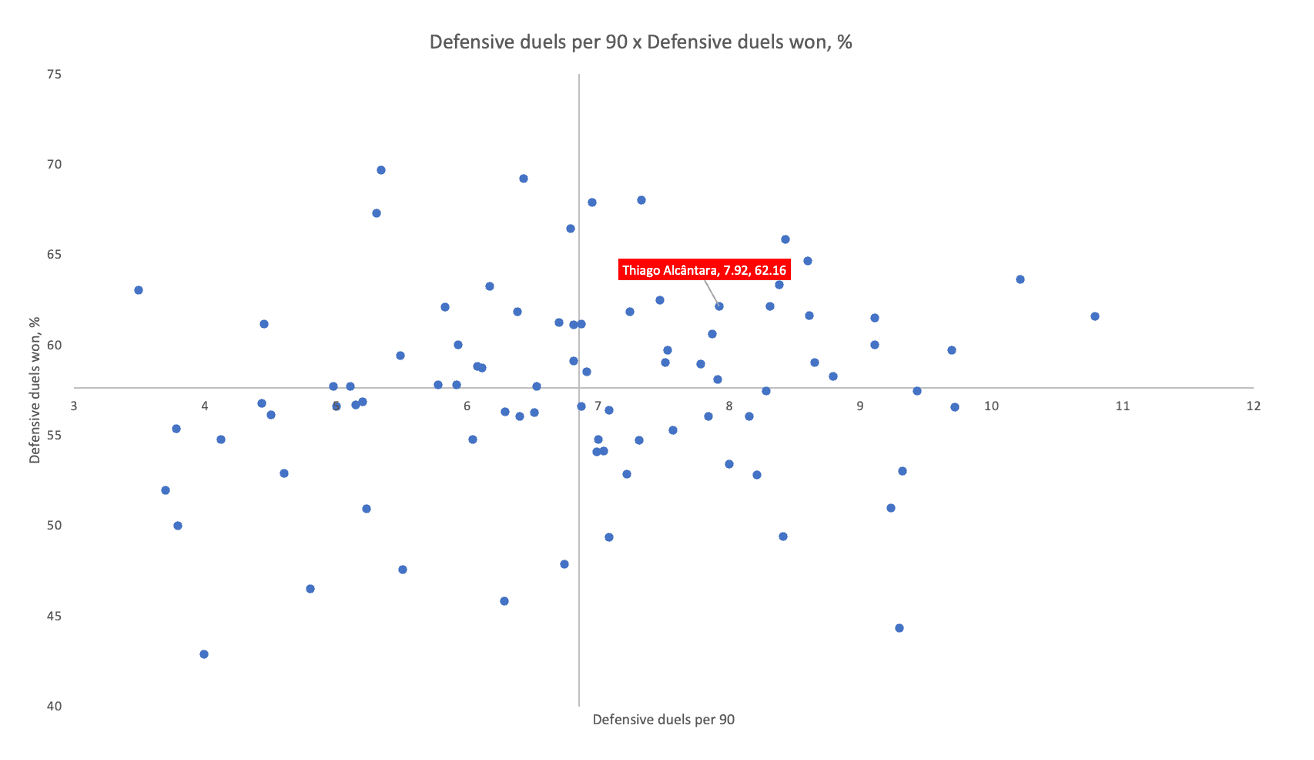
If you’ve watched Liverpool this season, it’s been very clear that Thiago never looked like a bad player as had been described. As an 8, he supported the high press very well to help his team maintain a compact shape in higher areas. Was he weak in terms of physicality? We have done some data analysis with the stats from Wyscout and it showed some interesting results. The data set only included all Premier League midfielders who played more than 10 games or 900 minutes this season.
Firstly, in terms of defensive duels per 90 and defensive duels won, in %, Thiago was in the top right quadrant, which means he was above mean in both metrics, he was never afraid of making challenges as he had 7.92 defensive duels per 90, and the success rate was quite high at 62.16%. All this shows he could take the ball back from the opposition in 1v1 situations.
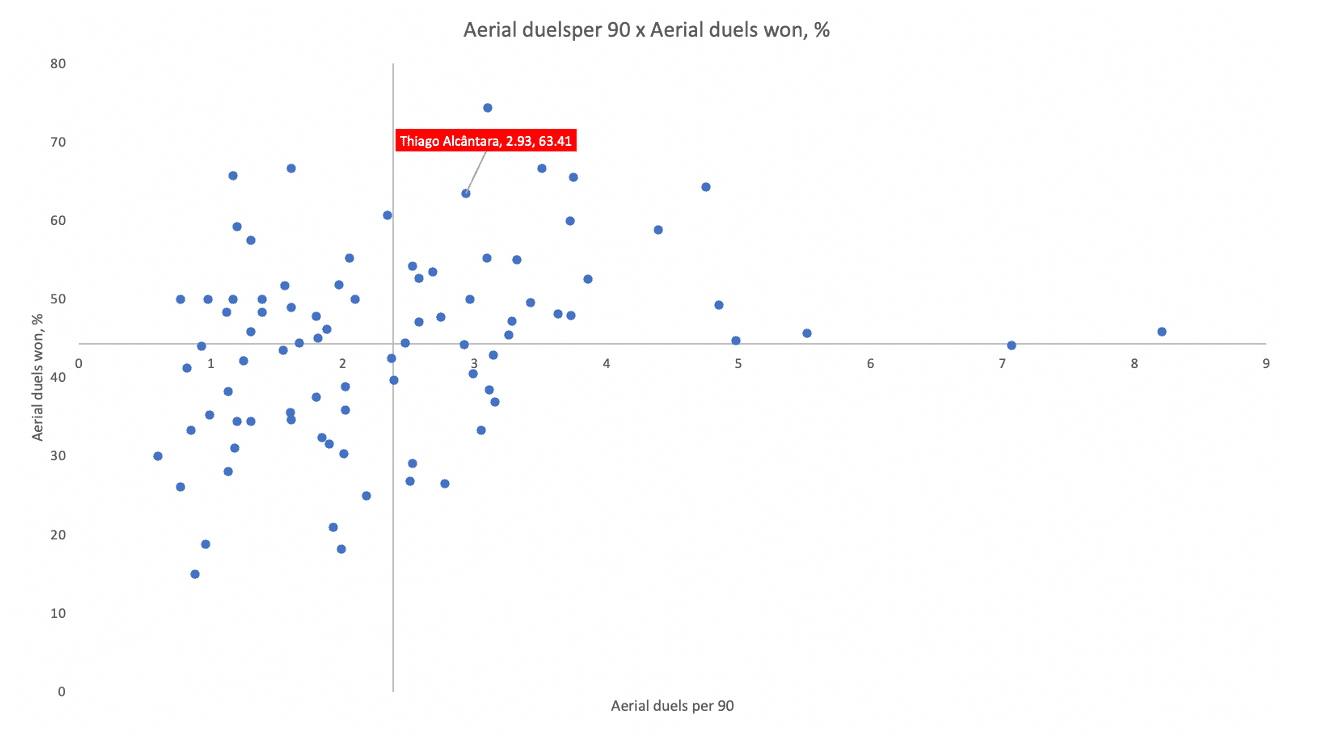
Aerially, an unphysical player like Thiago was usually being labelled as a weak spot in that regard, but that was clearly a misconception. The physical qualities are just an external condition that help the player, but even more important is the judgement, body angle, and other aspects. Thiago was the best example to show that you do not need to be as tall as Fabinho or Rodrigo Hernández to dominate in the air.
In the second scatter chart, we showed the aerial duels per 90 and aerial duels won, in % of Premier League players. Thiago, perhaps slightly surprisingly, ranks very high in this graph with 2.93 aerial duels per 90, and a 63.41% success rate. It shows he was not hiding in the aerial duels, having more attempts than mean, and with a good ability to win those duels compared to his counterparts.
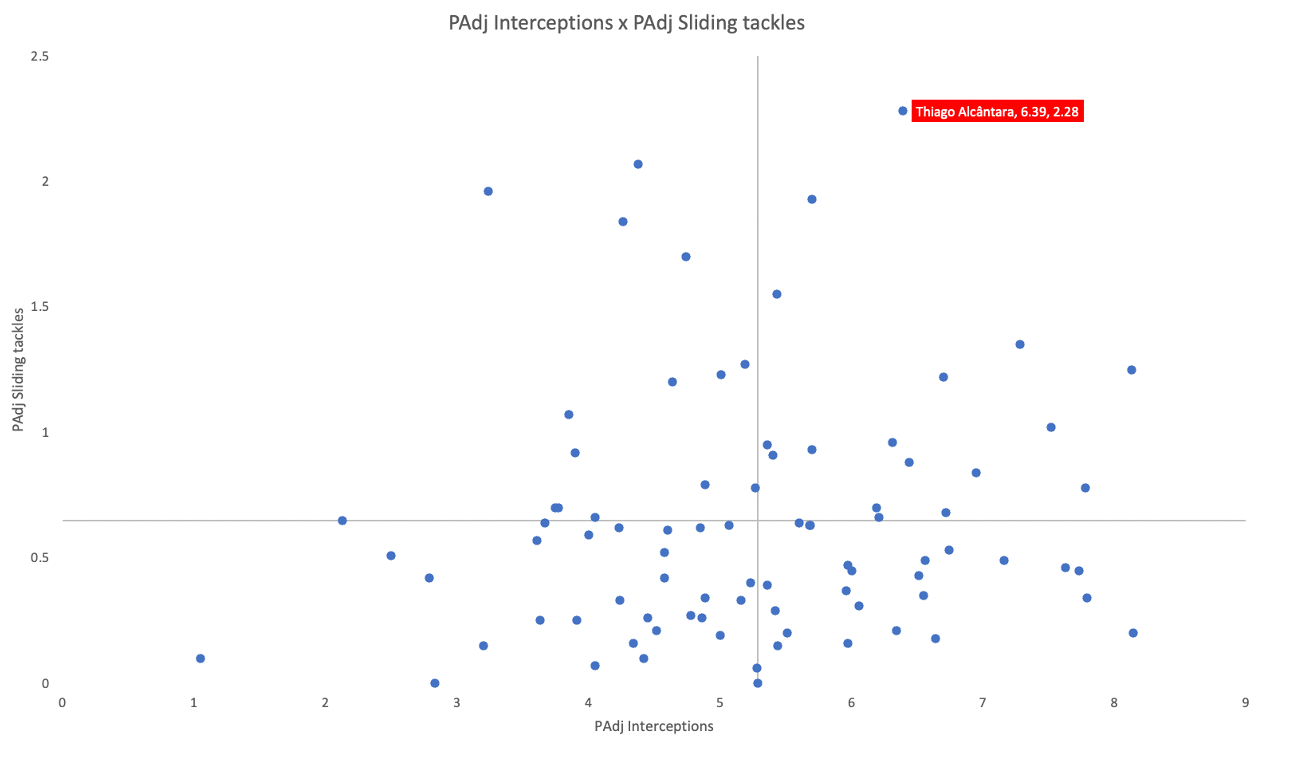
We could further examine the ability of Thiago to recover possession with the third scatter chart. In terms of PAdj interceptions and PAdj sliding tackles, he is almost the best midfielder in the league.
Thiago has 6.39 PAdj interceptions per 90, which is above the league average by some distance. While people might have thought Thiago is a stereotypical LaMasia graduate who only wants to play football in his own “beautiful” way, he can be an aggressive player who dives into tackles; his 2.28 PAdj sliding tackles lay behind no one — a notable stat with regard to his levels of physicality and defensive engagement, though admittedly not one which says ‘he’s a good tackler’. Still, it does dispel some of the myths that proliferated last season.
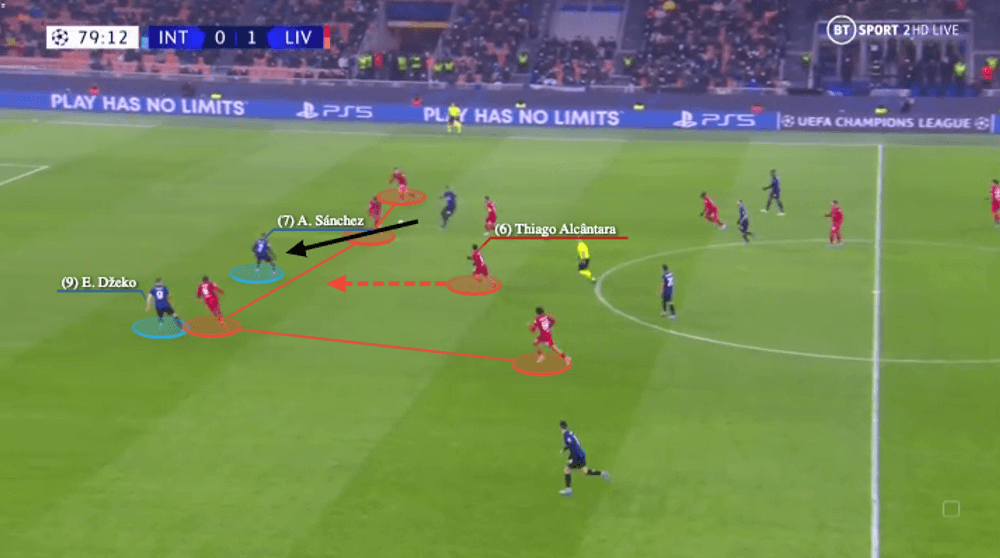
In this section, we are also showing Thiago’s smart defending with a game example. Rather than show how he was able to challenge the ball at a good angle or be aggressive in the press, we want to show his cleverness.
Here, Inter had a chance to break with two strikers running towards the high line. Thiago was tracking back, which is normal for a midfielder and we should not be surprised to see that. The question was, where should he go? To Alexis Sánchez, who was receiving the ball?
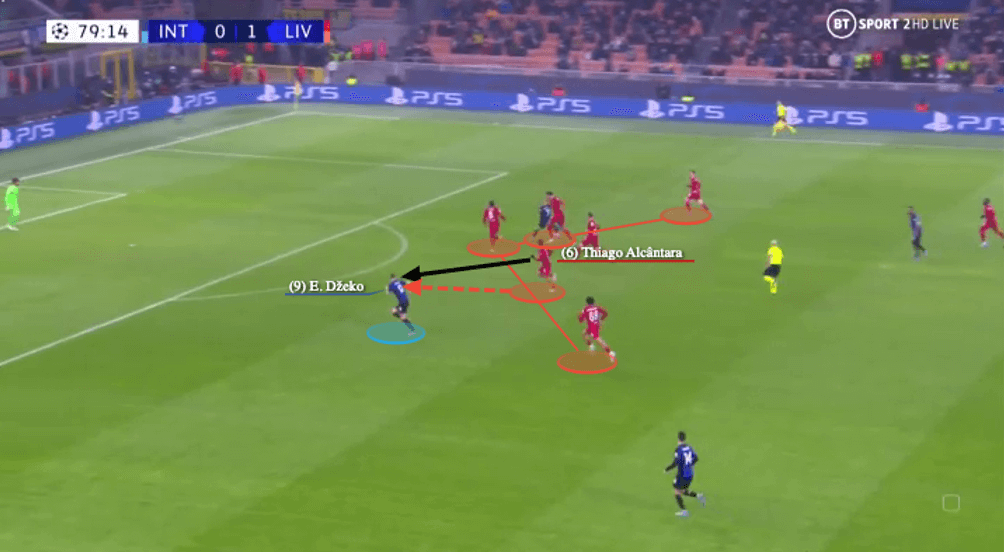
The answer was very clear just two seconds later, as Thiago saw both centre-backs were going for Sánchez, he knew the danger would not be there. Instead, since Ibrahima Konaté jumped, Edin Džeko was now without marking and Sánchez managed to connect the Bosnian striker with a pass. Because Thiago was calmly seeing everything and made good judgements, he tracked back to a good position to intercept that pass to prevent Inter from reaching the penalty zone, helping his side to secure a clean sheet.
This was not the only good defending he did for his team, in the section about transitions, we would share more examples of Thiago’s defensive techniques.
Conductor when Liverpool is in possession
In possession, Liverpool evolved a lot and they were not exactly the same team compared to years ago. Previously, they might have had more intensity to make runs behind, but now, they have a stronger ability to control the game and dictate the opponent, playing between the lines a bit more and that was attributed to Thiago’s good presence in the midfield.
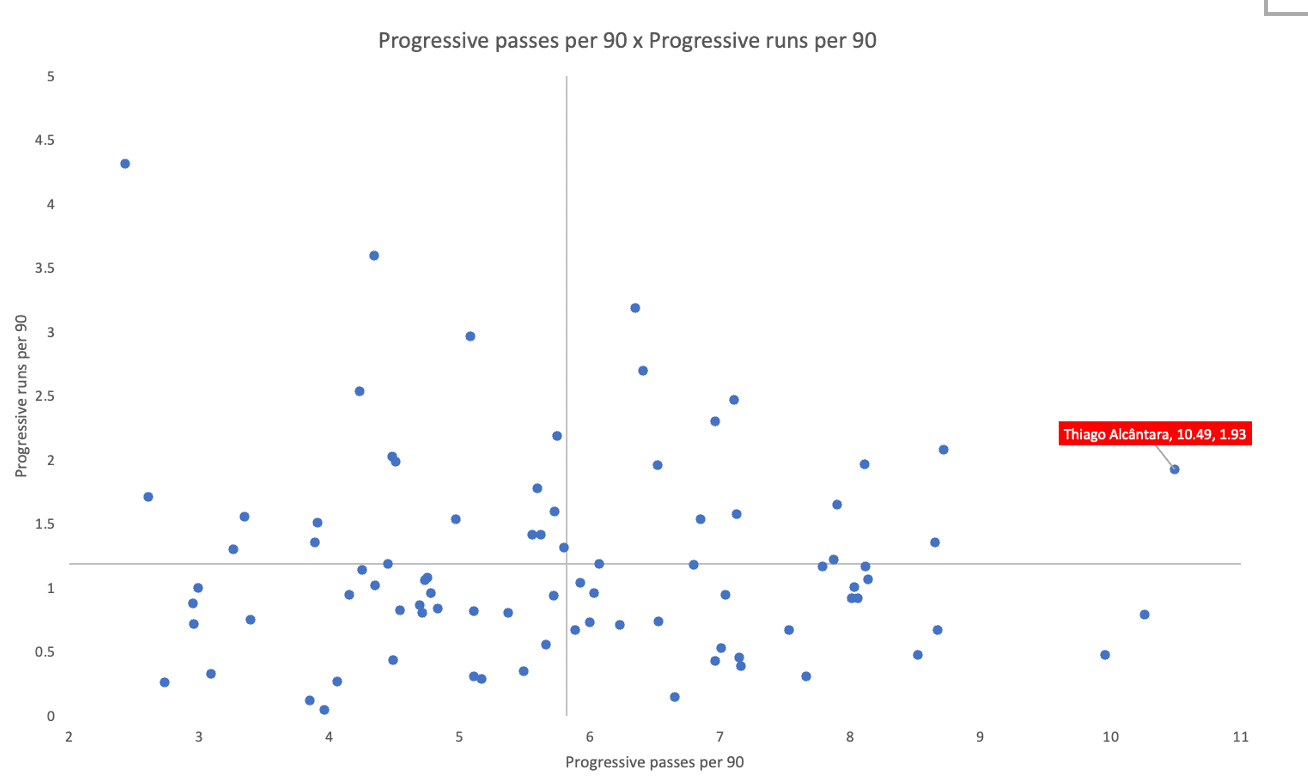
With numbers, we could see the playing style of Thiago as a Liverpool 8. In terms of progressive passes per 90, he is the best midfielder in Premier League with 10.49. That is a fair reflection of his exceptional passing ability and willingness to break the lines, and he could do it better than every other player in the league.
However, in terms of progressive runs per 90, Thiago’s 1.93 was also above the average but not ranking as high as his passes, but that was very fine given he was not a dribbler to carry the ball forward.
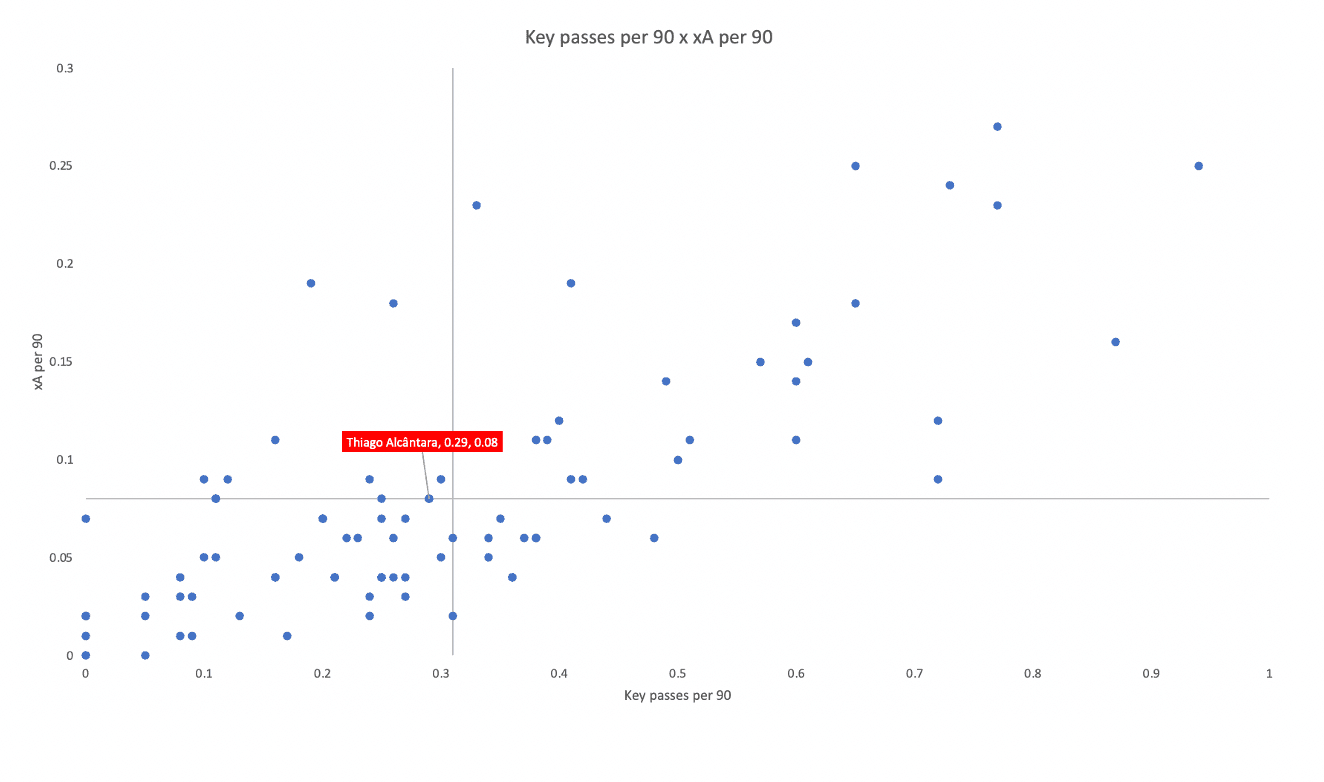
Speaking about a Spanish 8 who could slice good passes in a 4-1-2-3 system, maybe people thought Thiago would be doing things like David Silva — creating chances for his side. But Thiago is not in that same exact mould, as he only has 0.29 key passes per 90, below the average, and 0.08 xA per 90 which just about hits the mean. We should bear in mind that these numbers were just giving us an impression of the playing style of the player, as we are going to explain next, Thiago might not be impressive in these two metrics because he was playing quite deep for his side.
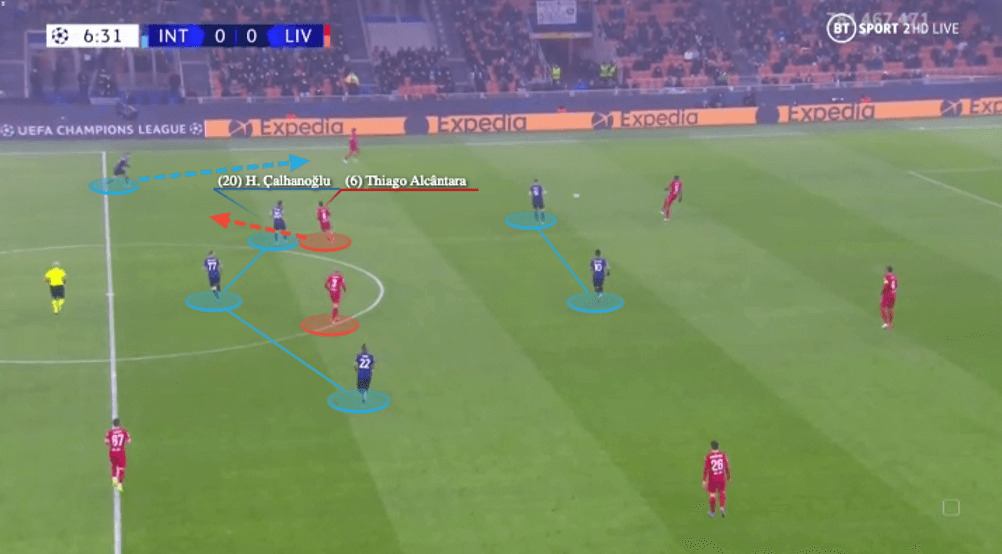
As we pointed out, Liverpool play more in the midfield this year because Thiago has a strong ability to bring the others into play. He is one of the cleverest players in the world who sees and analyzes the game on the pitch very quickly, having the technique, composure, and other good qualities to adapt to situations.
In the image above, we see Konaté finding the right-back, while Thiago oriented himself with Hakan Çalhanoğlu. As Trent Alexander-Arnold was going to receive the ball, Thiago initially wanted to move forward into spaces behind Çalhanoğlu to receive the ball as we noted in this image.
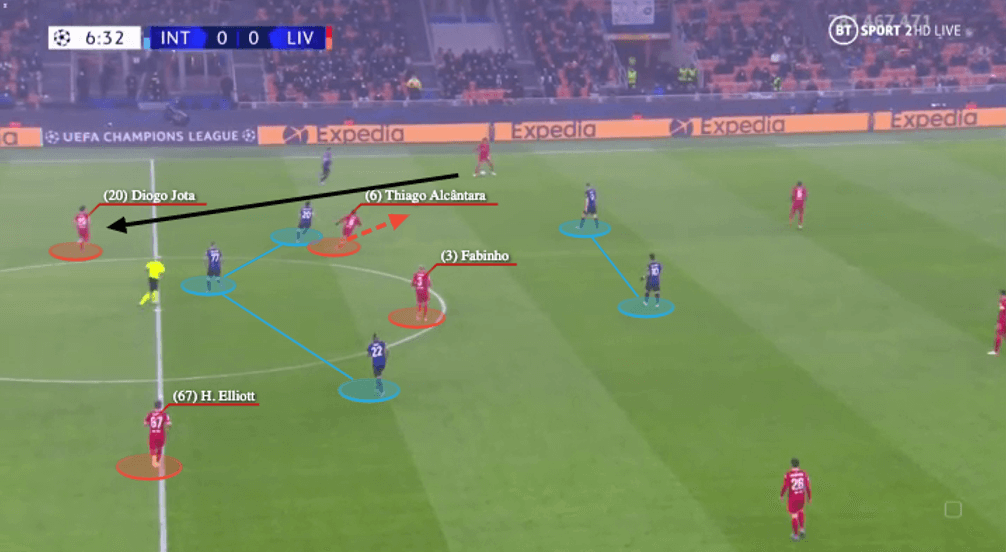
But things changed quickly on the pitch, as within a second, Thiago saw the striker was also dropping, if he went up, they killed each other’s space and that would be suboptimal.
Here came the good decision, as Thiago immediately changed his mind and decided to drop back to give Alexander-Arnold a lateral passing option, so if Çalhanoğlu followed, Diogo Jota could be free to receive. Or, alternatively, if Çalhanoğlu covered Jota in the midfield line, Thiago would find himself free beside his right-back.
Tactically, we could also see this movement of Thiago forming an obvious 4v3 numerical advantage for Liverpool in the centre, with the Reds occupying different heights and widths on the pitch, a free player was easily generated for ball progression.
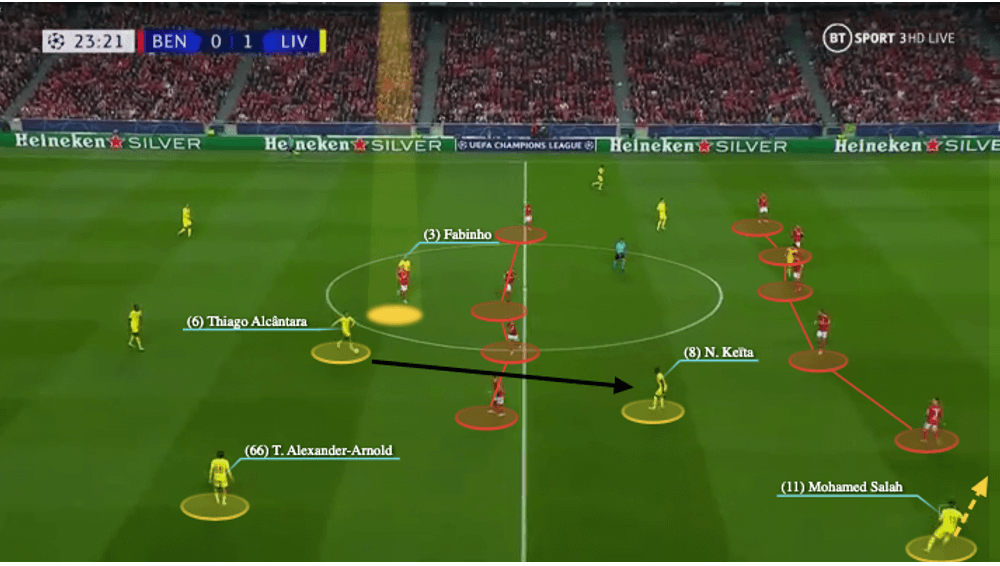
But Thiago’s contribution to Liverpool’s attack is not limited to off-the-ball movements. On the ball, he has top quality to bring the others into play as well. He often dropped deep from his ‘8’ position, receiving outside of the opposition formation so he did not have to put his back to the goal.
Here, against Benfica, when the opponent designed a defensive system with a striker man-marking the 6 (Fabinho), Thiago’s presence in the midfield would be pivotal to connect play. Here, he was able to receive in the parallel zone with Fabinho, but the striker could not close him.
Then, it was all about his willingness and strong mindset to break the lines. Here, Thiago had several options, the one to Alexander-Arnold was the easiest because no one was marking the right-back, but Thiago chose to pick Naby Keïta between the lines through that narrow passing channel. It was a very good pass as now Liverpool could face the last line when Keïta turned. Of course, the pass to Mohamed Salah was also viable but Thiago’s passing ability means that he could send the ball between the lines, so Liverpool did not have to run and run and counter-press all the time but kept the ball at his feet to dictate the oppositions more.
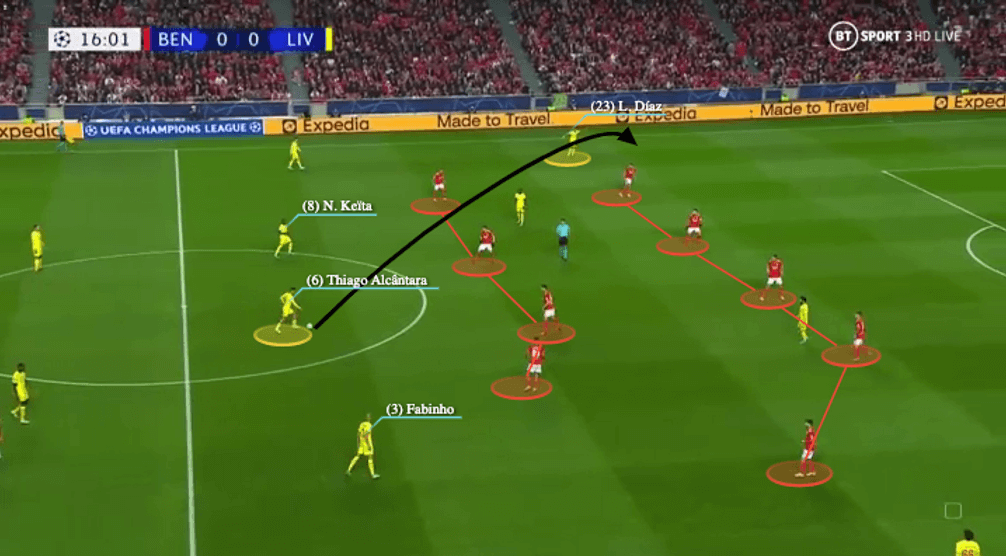
Thiago did play long passes, and he was very good at that, as he had top-level passing techniques to make switches to release the wide players. Here, again, Thiago dropped out of the formation to play and he was in the parallel zone with Fabinho and Keïta. Then, it was his time to perform as Thiago would not make meaningless square passes in the midfield. He had an excellent vision and the technique to help him play those long passes to reach the wide players, as he found Luis Díaz easily here.
In Liverpool’s context, that means they could let Thiago dictate the tempo of the game. Because he has a good understanding of the game, he can dominate the midfield by playing different kinds of passes — sometimes a longer one if they wanted to go behind and put the wingers in 1v1 situations to exploit the wide spaces, or they could keep the ball a bit more with Thiago connecting the dots.
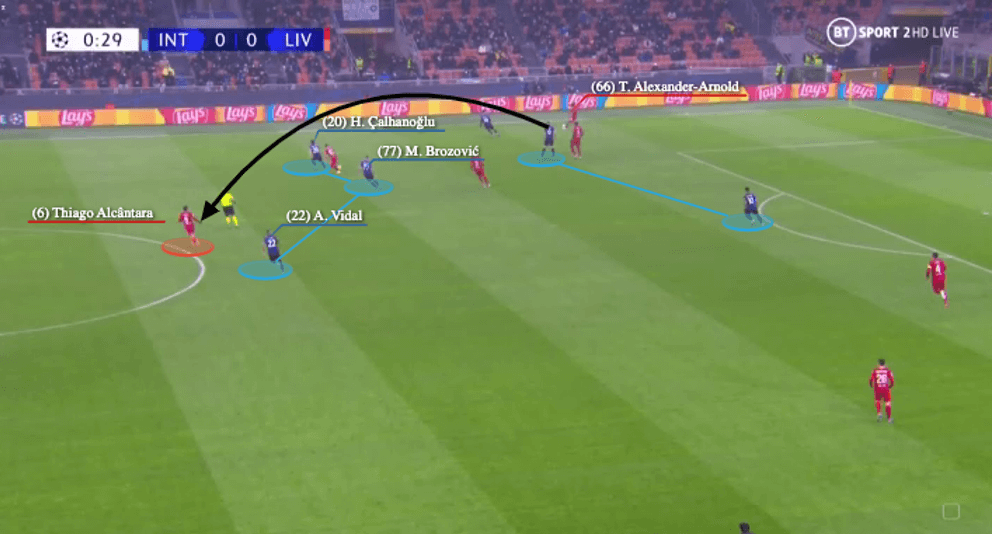
The last example of the section shows Thiago offering the team different elements. Instead of dropping deep, Thiago was able to adapt to situations and move into spaces if needed. Here, when Liverpool were playing out from the back, it made no sense if all Liverpool midfielders were staying in the parallel zones, it made the Inter midblock easy. When Harvey Elliot was slightly deep to pull Çalhanoğlu out, Thiago smartly anticipated the spaces behind the second line, making himself available for a chipped ball from Alexander-Arnold, and progression was easily made.
Hence, with this example, you can see how Thiago is a very well-rounded player, he can play deep to organise the attack, but he is also very comfortable at moving in spaces.
Transitions contributions
In transitions, Thiago looked like a mild player who might not be able to counter-press a lot, but instead, he is aggressive and has a strong ability to recover the ball, as the stats also tell.
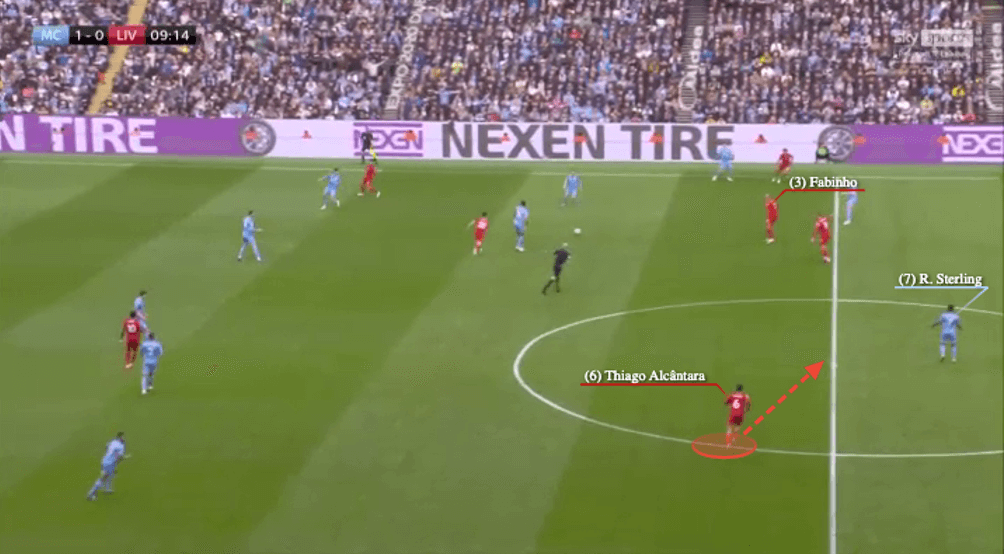
Apart from the tactical aspect, another valuable part of Thiago’s game is his cool head. He’s always calm and composed, even though things happen very quickly in the transitions.
In the first image of the section, City recovered the ball and now Fabinho was not in the centre, Thiago was moving back to the centre, the first reaction was good because he had the mindset to defend.
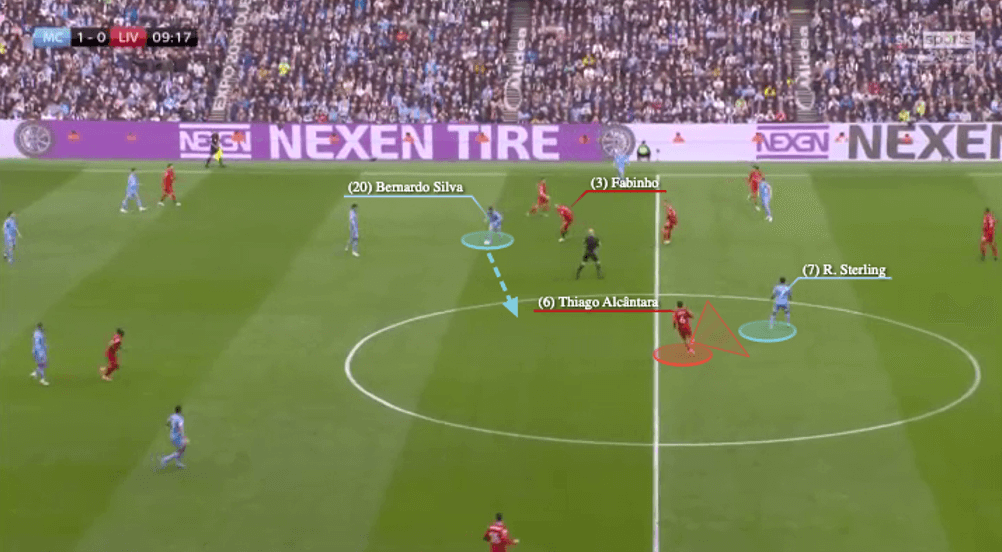
Only having the mindset was not enough, a more practical question was, how were you going to defend? That would directly affect the behaviour of Thiago. The former Barcelona man spotted Raheem Sterling’s presence, but instead of staying tightly to mark the man, Thiago paused a bit and located himself in that space.
In the meantime, Bernardo Silva was carrying the ball infield.
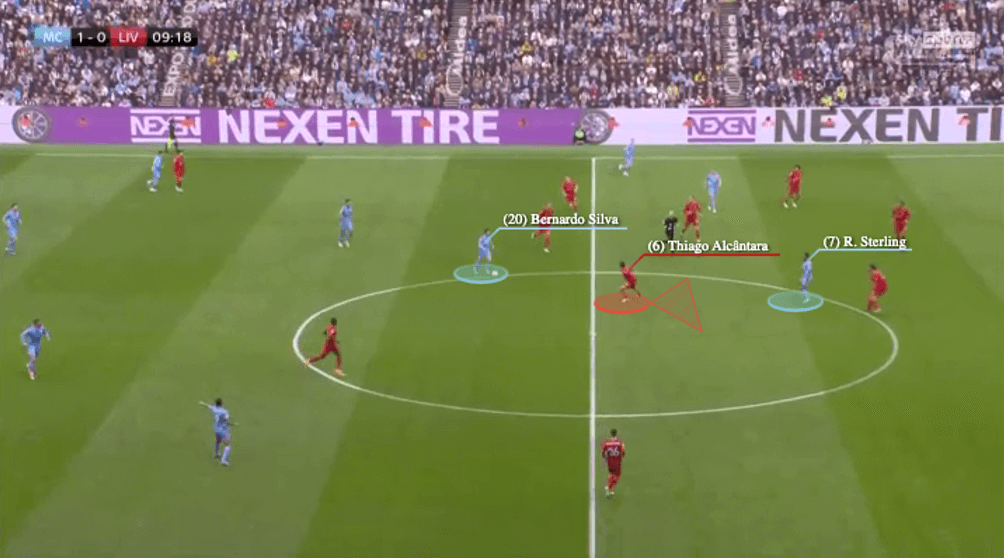
And you could see the positives after Thiago decided to stay in that space, he was in control in that area, achieving several objectives, such as closing Sterling’s space with Virgil van Dijk or blocking Silva’s passing channel to Sterling.
If he was too tight to Sterling, he would not be able to affect Silva’s run or decision because that was too far away from the Portuguese international.
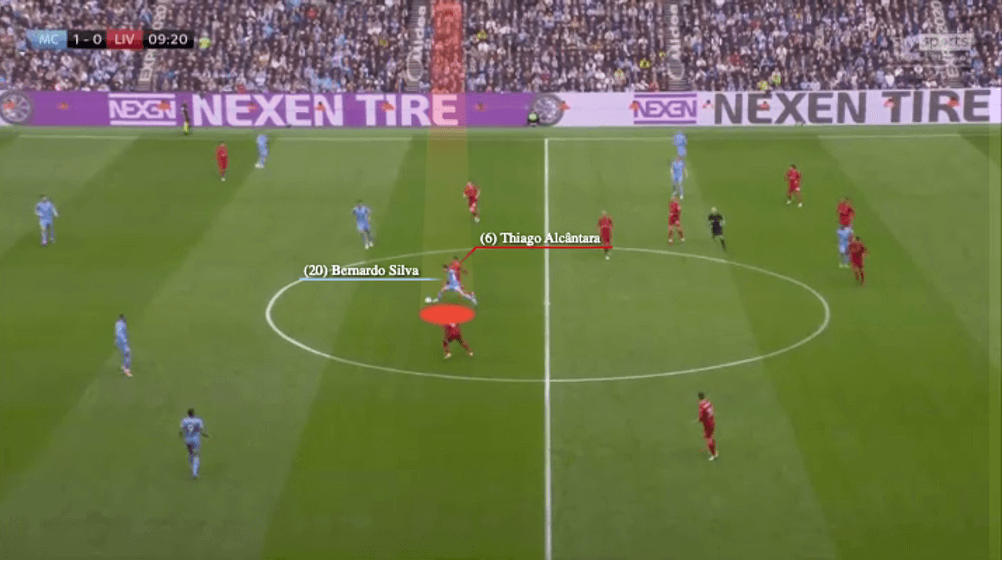
Because of Thiago’s good positioning, Silva could not pass, he was forced to further carry the ball but that turned out to be an occasion when Thiago came out to press. You could see in that image when Thiago made the challenge, the angle was good and he made clear contact with the ball, stealing it from a technically great player.
This example showed several good aspects of Thiago in TAD. Firstly, he was able to control the space, and secondly, he had the ability to win the ball back, which matched the findings of our data analysis in the above section.
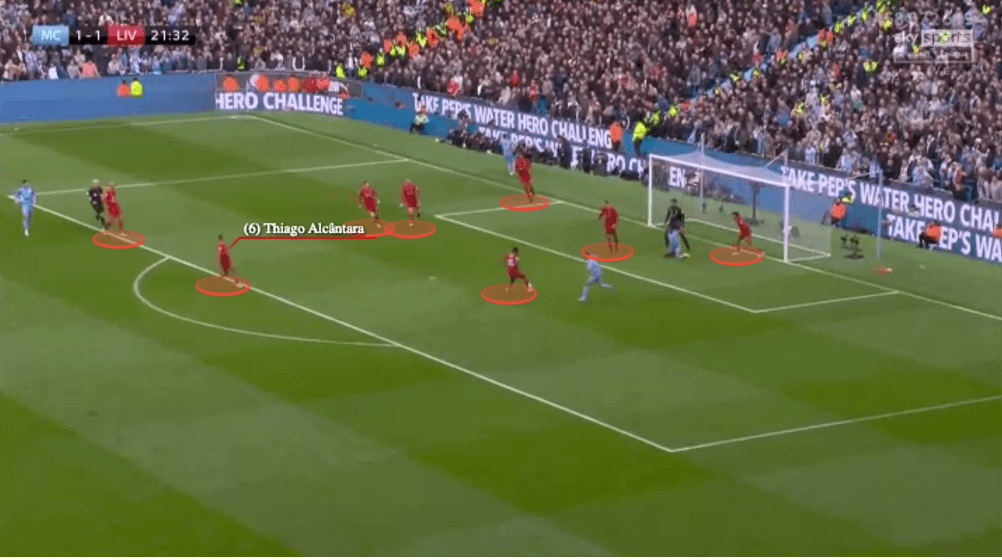
In TDA, Thiago is also an influential player because he anticipates well. Also in this example against City, when Liverpool were defending, Sadio Mané retrieved the ball in the box and Thiago’s body position was closed initially.
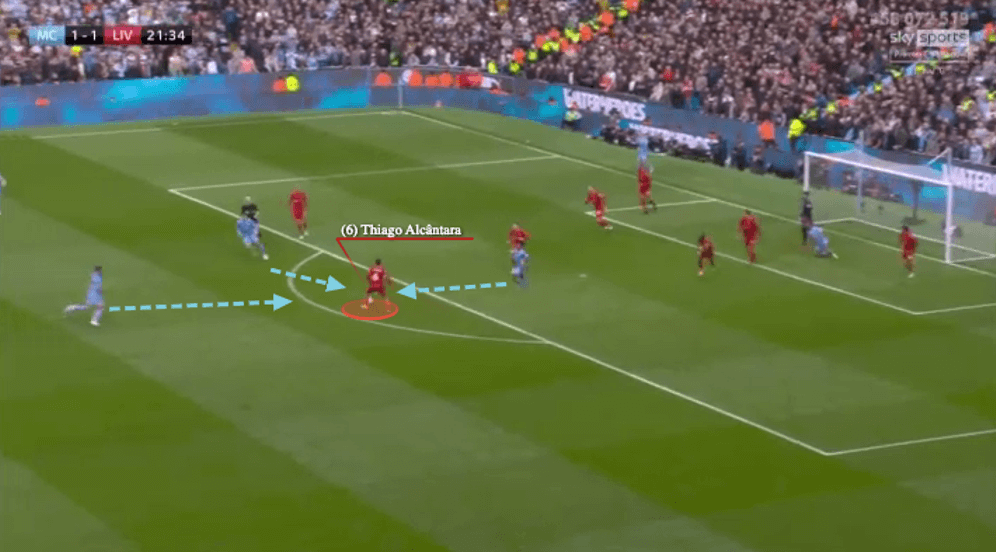
But when Mané found Thiago, before the ball arrived, you could see the Spaniard was very ready for the pass. Firstly, the body angle was slightly adjusted, he was not closing it entirely, he opened up a bit so he could control with his far foot. That also helped create the angle for the next move, and he was not static.
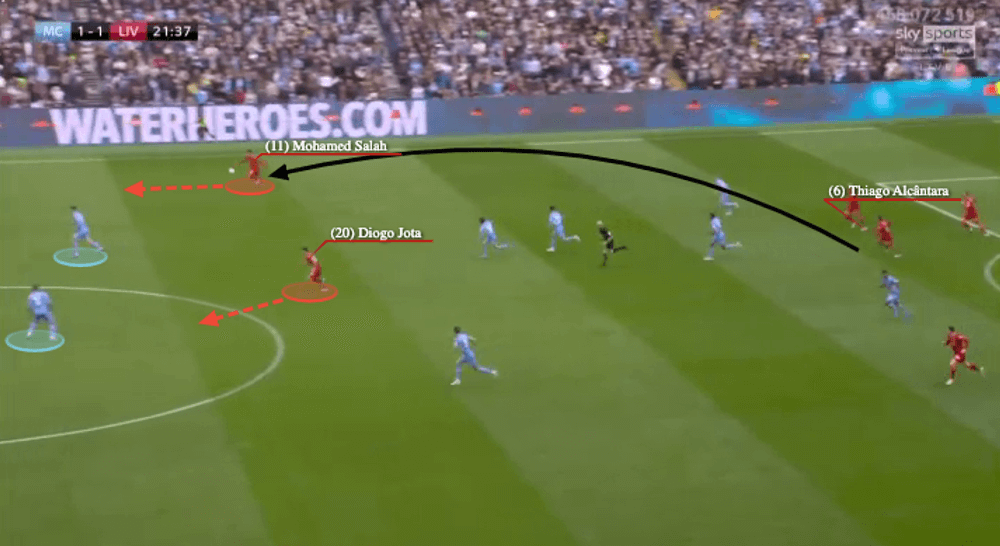
The next pass was magical because Thiago simply picked Salah in the front, which was impressive given that he did everything in five seconds. Now, Liverpool’s rest offence had a good moment to counter because of Thiago’s good work to make things happen.
Conclusions
As we concluded in this tactical analysis, Thiago is literally one of the best midfielders in the world with an exceptionally high football-IQ — he’s mastered all phases of the game. He was able to transform Liverpool and Klopp’s tactics to another level, by adding the dynamics in their attack, without compromising elements of their defence. It was a pleasure to watch his football and many elements he demonstrated were the basic, simple, but very vital techniques in football. Now he is mostly an 8, but he could be more flexible than that, with the potential to fit into the squad as a 6 or a 10. He also provides proof of the claim that football is a game played with your brain, and you do not have to be sizable to be a top-level Premier League midfielder.

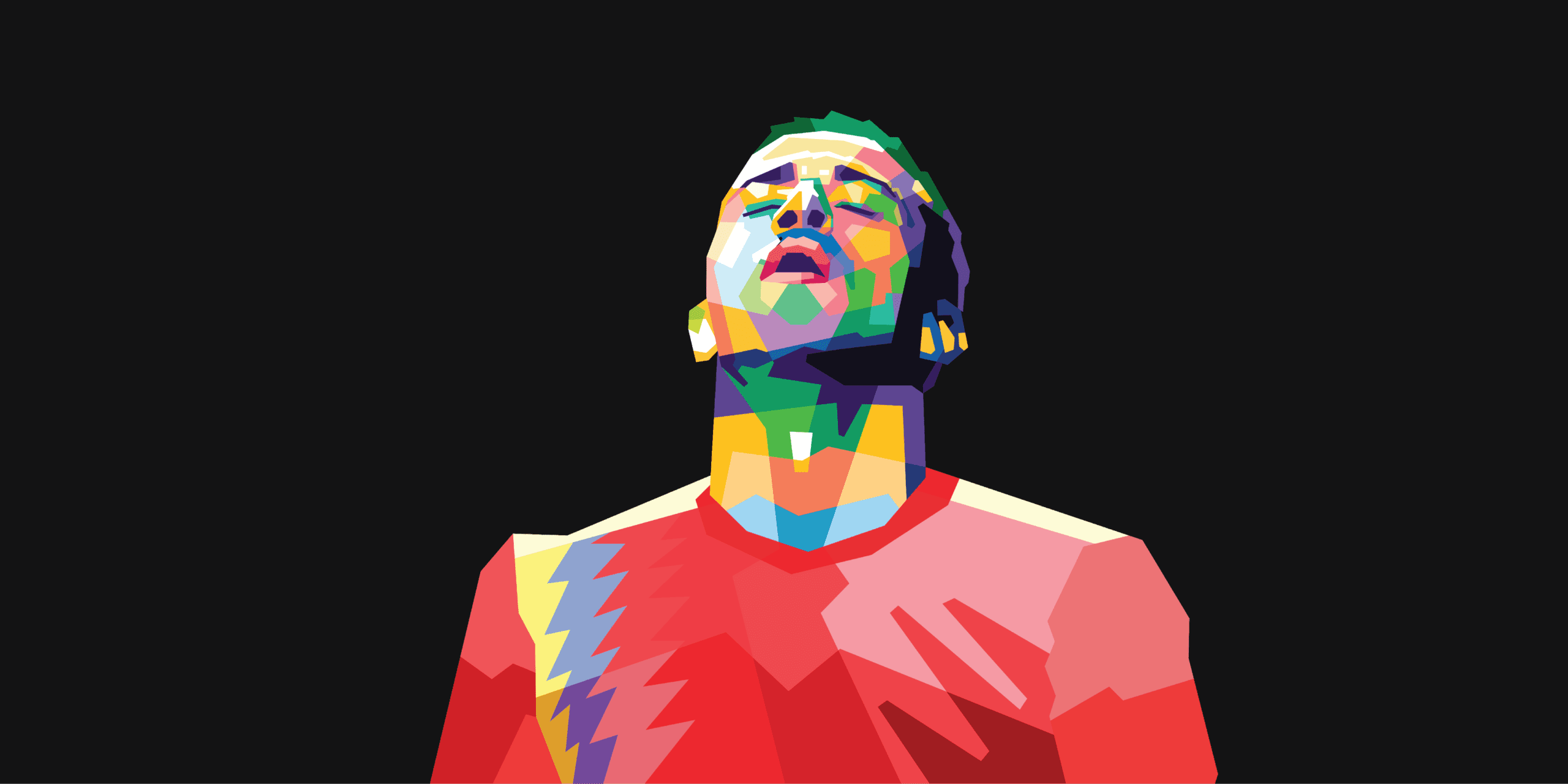



Comments